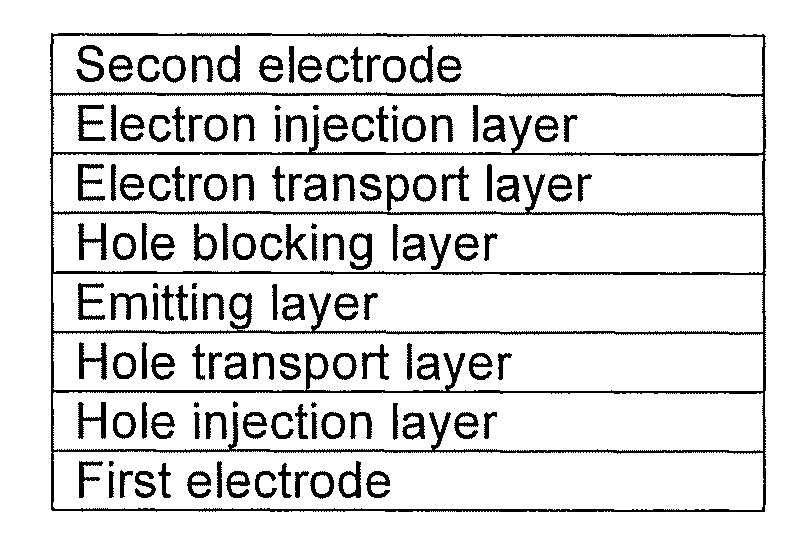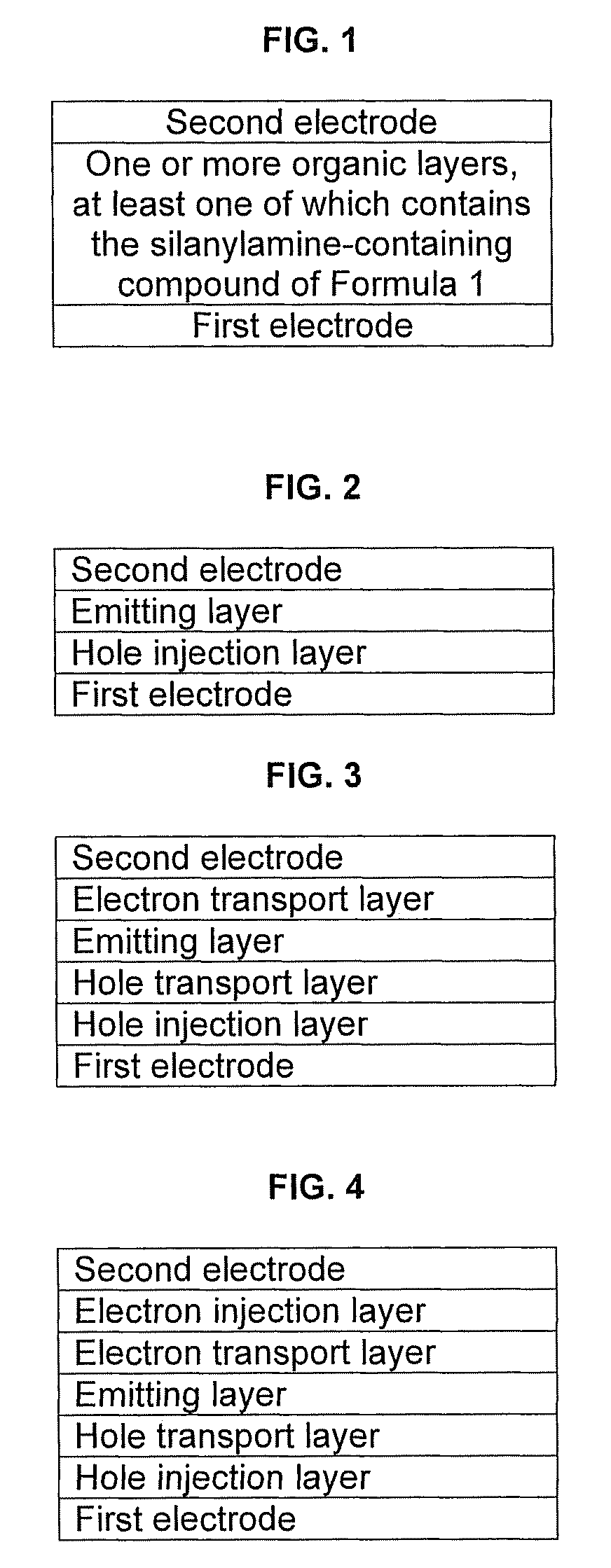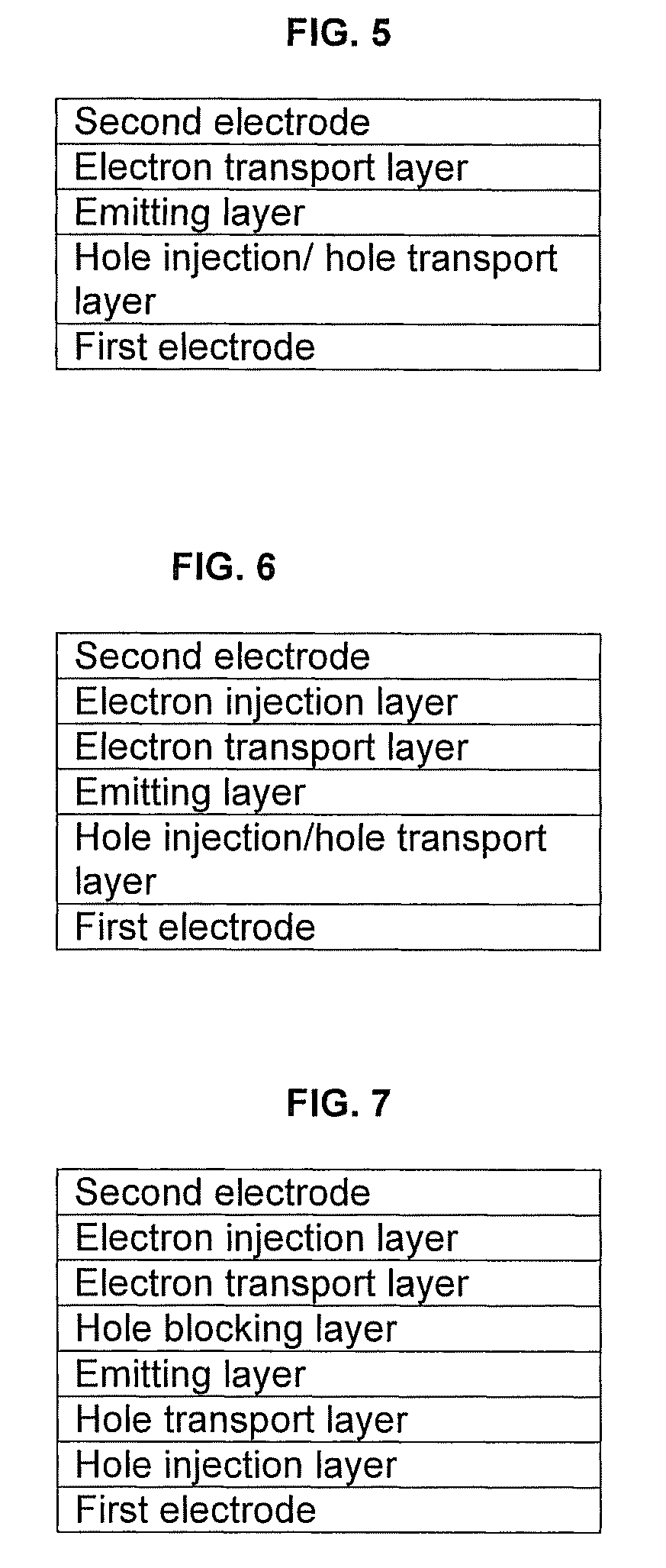Silanylamine-based compound and organic light-emitting device including organic layer including the silanylamine-based compound
a technology of silanylamine and compound, which is applied in the direction of discharge tube luminescnet screen, natural mineral layered products, etc., can solve the problems of unsatisfactory layer materials, unsatisfactory lifetime, efficiency, power consumption characteristics, etc., and achieve low driving voltage, high brightness, and high efficiency
- Summary
- Abstract
- Description
- Claims
- Application Information
AI Technical Summary
Benefits of technology
Problems solved by technology
Method used
Image
Examples
synthesis example 1
Synthesis of Compound 1
[0074]A compound 1 was synthesized according to Reaction Scheme 1 below.
[0075]
Synthesis of Intermediate A
[0076]Carbazole (2.433 g, 10 mmol) was added to an 80% acetic acid (100 ml), and iodine (I2) (2.714 g, 10.7 mmol) and ortho-periodinic acid (H5IO6) (0.666 g, 2.92 mmol) in a solid phase were added thereto. The reaction mixture was stirred at 8° C. under a nitrogen atmosphere for three hours. After the reaction was terminated, the reaction solution was extracted three times with ethylacetate (50 ml). The collected organic layer was dried over magnesium sulfate to evaporate the solvent. The resultant residue was purified by silica gel column chromatography to give an intermediate A as a white solid (4.21 g, yield: 85%). 1H NMR (CDCl3, 400 MHz) δ (ppm) 8.28 (m, 2H), 7.72 (d, 2H), 7.56-7.32 (m, 7H); 13C NMR (CDCl3, 100 MHz) δ (ppm) 139.1, 135.8, 130.6, 129.8, 127.4, 127.1, 123.0, 121.1, 116.3, 84.9.
Synthesis of Intermediate B
[0077]The intermediate A (4.95 g, 10...
synthesis example 2
Synthesis of Compound 4
[0080]A compound 4 was synthesized according to Reaction Scheme 2 below.
[0081]
Synthesis of intermediate D
[0082]The intermediate B (0.537 g, 0.856 mmol) and 4-fluoroaniline (0.133 g, 1.2 mmol) were dissolved in toluene (5 ml), and t-BuONa (0.144 g, 1.5 mmol), Pd(dba)2 (0.018 g, 0.02 mmol), and (t-Bu)3P (0.004˜0.006 g, 0.02˜0.03 mmol) were added thereto. The reaction mixture was stirred at 80° C. for five hours. The reaction solution was extracted three times with ethylether (20 ml). The collected organic layer was dried over magnesium sulfate to evaporate to the solvent. The resultant residue was purified by silica gel column chromatography to give an intermediate D (0.371 g, yield: 71%). 1H NMR (CDCl3, 400 MHz) δ (ppm) 8.61 (d, 2H), 8.53 (s, 1H), 8.12 (dd, 1H), 7.95-6.94 (m, 26H), 6.94 (bs, 1H); 13C NMR (CDCl3, 100 MHz) δ (ppm) 159.0, 156.4, 140.7, 140.5, 135.7, 135.1, 133.6, 133.4, 133.0, 131.7, 129.8, 129.6, 127.9, 127.4, 127.1, 123.3, 122.3, 120.4, 116.2, 1...
synthesis example 3
Synthesis of Compound 11
[0084]A compound 11 was synthesized according to Reaction Scheme 3 below.
[0085]
Synthesis of Intermediate E
[0086]Carbazole (16.7 g, 100 mmol), 4-iodotoluene (28.3 g, 130 mmol), CuI (1.9 g, 10 mmol), K2CO3 (138 g, 1.0 mol), and 18-crown-6 (530 mg, 2 mmol) were dissolved in 1,3-dimethyl-3,4,5,6-tetrahydro-(1H)-pyrimidinone (DMPU) (500 ml), and the reaction mixture was stirred at 170° C. for eight hours. After the reaction was terminated, the reaction solution was cooled to room temperature, and a solid material was filtered out. A trace amount of an ammonia solution was added to the filtrate, and the resultant solution was extracted three times with diethylether (300 ml). The collected diethylether layer was washed with excess distilled water, dried over MgSO4, filtered, and dried under a reduced pressure to obtain a crude product. The crude product was purified by silica gel column chromatography to give an intermediate E as a white solid (23.4 g, yield: 91%). ...
PUM
| Property | Measurement | Unit |
|---|---|---|
| temperature | aaaaa | aaaaa |
| thickness | aaaaa | aaaaa |
| temperature | aaaaa | aaaaa |
Abstract
Description
Claims
Application Information
 Login to View More
Login to View More - R&D
- Intellectual Property
- Life Sciences
- Materials
- Tech Scout
- Unparalleled Data Quality
- Higher Quality Content
- 60% Fewer Hallucinations
Browse by: Latest US Patents, China's latest patents, Technical Efficacy Thesaurus, Application Domain, Technology Topic, Popular Technical Reports.
© 2025 PatSnap. All rights reserved.Legal|Privacy policy|Modern Slavery Act Transparency Statement|Sitemap|About US| Contact US: help@patsnap.com



